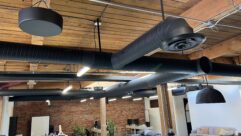Sounds of silenceKeeping the privacy in an open-environment office means taking special carewith parts and materials.
Nov 20, 1996 12:00 PM,
David MarshMarsh is a consultant with Pelton Marsh Kinsella, a division of Carter & Burgess, Dallas
It was a Texas-size pro-ject from the start when the retail giant J.C. Penney decided to move its corporate headquarters from New York to Plano, TX. When it was finished, 3,600 employees would occupy a four-level, 2.2 million ft2 (204,380 m2) building sprawled over an area equal to approximately five football fields.
The architectural firm HKS hired Pelton Marsh Kinsella (PMK) as acoustical consultant for the headquarters building, in which nearly 80% of the office areas would be open-plan. At the outset, the owner placed a priority on office acoustics. In addition, the new building presented even more acoustical challenges because its facilities include a fitness center, child-care center, visitor’s center, museum, television studios, print shop, employee dining area, ballroom-style multipurpose meeting rooms, a training center and a large atrium with a central rotunda that measures 60 foot (18.2 m) in diameter.
Before design of the building began, J.C. Penney leased interim office space in three office buildings, moving employees from a closed-plan office environment in New York to an open-plan. An employee survey revealed considerable dissatisfaction with the acoustics of the interim offices – especially a lack of speech privacy.
In an open-plan office, employees are separated from each other with partial-height screens instead of floor-to-ceiling partitions. Depending on the open-plan design, it may be nearly impossible for an individual to talk on the telephone without being overheard. Employees cannot simply shut the door on noise from adjacent telephones, computers, printers or copiers, vending machines, document shredders and extraneous conversations.
In any office environment, it is important to have a little of your own space. Intruding noises can interrupt concentration; overheard conversations entice others to participate. Either situation leads to lower productivity. A well-designed office should provide relative freedom from distraction and give sufficient speech privacy.
A sound-masking system will not solve all these problems. I visited a project where the telephone intercom from one office could be heard and understood in the next office even though the sound-masking system was operating above the highest usable level of about 47 dBA and the HVAC system was producing 50 dBA. A successful sound-masking system is part of an acoustical environment using good space planning, effective barriers, careful placement of absorptive materials and judicious use of background noise.
Space planningControlling the distance between people in the space is one method of controlling noise levels between them. If the cubicles are too small, workers will not have a sufficient distance between them to have any degree of speech privacy. The furniture within cubicles should be arranged to keep workers from facing the doorway openings and, if possible, from facing each other. Doorway openings should be staggered so direct paths do not exist between workers in cubicles that are across from each other.
The layout of an open-plan environment should consider not only the individual work station, but also the arrangement of the entire room. Similar functions should be grouped together, and communal areas should be planned to minimize the effects of conversations on other groups. It is best if the entire open-plan area is surrounded by a walkway to keep the dividing screens from butting up to the perimeter walls or windows, to prevent sound reflections.
BarriersIn closed-plan office areas, the acoustical enclosures are made up of partitions, doors and ceilings. Open-plan offices must rely on partial-height screens as the only barriers.
Transmission loss (TL) is the attenuation of sound through a barrier at a given frequency. Because TL is different for each frequency, the acoustical design industry has developed a standardized, single-number rating system called sound transmission class (STC), which emphasizes the speech range of different frequencies.
Although STC rating is important in screen selection, the most important consideration is height. To be effective, the dividing screens must interrupt the direct path from talker to listener. J.C. Penney used relatively high screens in its interim lease spaces, but the company thought they adversely affected perception of the overall open-plan size and placed heavier demands on the lighting layout. PMK evaluated the barrier effect of different screen heights and found that with other improvements, the height could be reduced somewhat without being a detriment to speech privacy.
Given a good STC rating and appropriate height, effort should be made to restrict the level of sound skirting or flanking around the dividing screens. Higher-quality modular furniture systems usually have screens with connectors that provide a satisfactory acoustical seal. These screens should rest against the floor without air gaps across the bottom.
Absorptive materialsThe approach to most noise control problems is to reduce the noise at its source, then along its path and finally at the receiver.
Acoustically absorptive finishes are used on open-plan office furniture systems, primarily on the screens, to reduce sounds within the employees’ workstations. If the screens are doing their job, the primary sound path will be only ceiling reflections.
Fabric-faced fiberglass is one of the most common acoustical finish materials used on divider screens. Walls along the walkways bounding the open-plan areas should be treated with acoustical wall panels to reduce conversation sound levels.
Background noiseOne of the chief tasks of an office acoustics project is to establish appropriate design criteria for background noise in all occupied spaces. Steady-state noise from heating, ventilation and air conditioning (HVAC) electrical and plumbing systems must be controlled. Large, built-up air-handling units are in the penthouse structures, and fan-powered mixing boxes and variable air volume (VAV) boxes are in the air plenum spaces above the office ceilings and the central plant. The central plant is a big room in the basement filled with noisy equipment attached to piping hanging off the floor slab above. The plant transmits noise and vibrations throughout the building.
The sound-masking system designAcoustics is as much about making things appropriately noisy as it is about making things quiet. HVAC systems provide steady-state background noise, which, at the right level, covers up or masks speech from being understood. One of the J.C. Penney design and construction staff joked that they were paying us to make the real HVAC systems quiet while designing an electronic sound-masking system to simulate the HVAC system noise.
Masking noise needs to have consistent tonal quality and level. The tonal quality and level of HVAC noise nominally varies from area to area in a building and may change throughout the day as the heating and air conditioning demand changes. For this reason a masking system provides the desirable noise at an appropriate sound level; the HVAC systems are designed to operate at slightly lower levels.
A sound-masking system uses loudspeakers suspended in the air plenum above the ceiling and aimed upward toward the structural deck to create a uniform field of masking noise. The loudspeaker spacing and transformer taps should consider the STC of the ceiling. The layout should also consider ceiling penetrations by light fixtures, return air openings and even supply air diffusers connected by flexible ducts, because each of these will affect the tonal quality.
The J.C. Penney headquarters sound-masking system uses nearly 8,000 Lowell masking loudspeakers covering all of the private and open-plan office areas and the sample rooms where buyers look at merchandise.
The sample rooms are separated from adjacent open-plan office areas by demountable partitions, providing the flexibility to revise or expand the layout in the future.
The loudspeaker system uses alternating A and B channels fed by independent noise generators. This setup provides a noticeable reduction of the flanging effect you will sometimes observe when you walk between loudspeakers in a monaural masking system.
The Lowell masking units were specified with custom-wound transformers with 1.5 dB taps instead of the standard 3 dB taps. The unit’s rotary selector switches afford more precise level adjustments near ceiling penetrations. ASC Sound of Plano, TX, installed the loudspeakers and other parts of the masking system.
Other key components of the J.C. Penney sound-masking system are 24 CT-800 and 23 CT-200 Crown power amplifiers, 12 White Instrument 4700-2 dual-channel programmable equalizers and four Lyntec PAC-2A2N programmable audio controllers. Each controller has two noise generators with programmable attenuators.
The Lyntec units are set to reduce automatically the masking noise level after hours in 1.5 dB increments every 20 minutes and increase it again gradually to the normal operating level at the beginning of each work day.
The expansiveness of this project precluded use of a centralized approach to the system, so the electronics are in 12 sectional wall racks distributed throughout the building.
The atrium zonesThe atria in this building were of particular importance because they are adjacent to open-plan office areas. Glass acoustically isolates the lower level offices.
The central rotunda is the largest atrium space and is the common pathway to the escalator leading to the lower-level employee dining area. PMK analyzed the potential for conversational noise intrusions from this large cathedral-like space to the nearby second- and third-level office areas. Ultimately, PMK concluded that the combined effects of distance, barriers and masking noise could adequately address the noise situation.
On each level of the building where open-plan areas are connected to atriums, separate sound-masking zones allow different level settings and equalization. The atria zones are fed by their own Lyntec units to allow different times to be programmed for stepping up and stepping down the levels.
Whirlwind resultsAfter moving into the new headquarters building, J.C. Penney expressed satisfaction with the overall acoustics and specifically with the level of speech privacy achieved in the open-plan office areas.
During the first year of occupancy, tornadoes were moving toward Plano, so the building emergency evacuation system announced safety instructions to the employees. Many people could not hear the announcements, and most of those who did could not understand the instructions. The emergency evacuation system barely met the NFPA minimum sound-level requirements. This had not been identified as a significant problem because system demonstrations for the fire marshall had been done with the sound-masking system turned off. Fortunately, the tornadoes never made it to Plano.
Though PMK did not design the emergency evacuation system, J.C. Penney hired the company to fix the problem. PMK discovered that the announcement system was under-powered; too much current was being drawn from the power amplifiers, which was causing significant distortion.
PMK recommended first adding compression, equalization and a Hughes speech processor to the microphone signal chain. The next step up would be to attenuate the masking system to its nighttime level during emergency announcements. The final step would be to feed the emergency page signal to the masking loudspeakers throughout the building.
At the client’s request, all of the conditions in any combination were mocked up in one area of the building and demonstrated for J.C. Penney personnel, who decided all three recommendations should be implemented. The mock-up demonstration was repeated for the fire marshall, complete with emergency bypass functions. The fire marshall accepted the modifications, and ASC Sound installed all of the equipment required to make the changes permanent.
The new J.C. Penney headquarters in Plano serves as a paradigm for acoustic design of corporate office environments. All of the owner’s acoustical goals were met through the inclusion of acoustical expertise in interior design and implementation of a properly designed sound-masking system.










